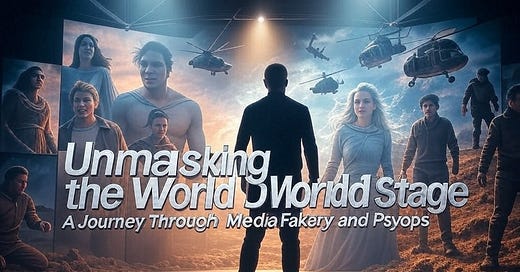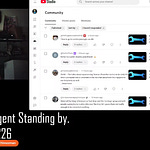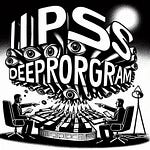( I used AI to write my transcript as a book outline)
In an era where information is both weapon and shield, this book invites you to question the reality presented by media, culture, and institutions. Born from a raw, unfiltered podcast recorded on April 28, 2025, these pages capture a relentless pursuit of truth amidst a landscape of orchestrated narratives. From flat earth feuds to Hollywood's predictive programming, this is not just a transcript but a manifesto for media skepticism. Prepare to see the world stage for what it is—a carefully scripted performance.
Table of Contents
Introduction: The Desert of the Designated Real
Flat Earth Drama: A Circus of Cease and Desists
The Art of Fakery: From Action Figures to AI Popes
Predictive Programming: Hollywood’s Script for Reality
The Q Conundrum: Psyops and Proud Boys
Media Skepticism: Why Journalists Aren’t Journalists
The Metascript: James Cameron and the Sinking West
Eco-Terrorists and Useful Idiots: The Politics of Psyops
Conclusion: Becoming Your Own Source
Appendix: Psyop Trading Cards and Further Reading
Chapter 1: Introduction: The Desert of the Designated Real
“We are in the desert of the designated real.”
This book begins with a bold assertion: the reality we consume is a construct, a “designated real” crafted by media, governments, and cultural influencers. In this opening chapter, we dive into the mindset of the speaker—a relentless skeptic who sees the world as a stage for psychological operations (psyops). The transcript, recorded on April 28, 2025, is a snapshot of a live podcast, raw and unfiltered, where the speaker dissects everything from flat earth controversies to AI-generated popes. This chapter sets the stage by introducing the concept of media fakery and the importance of questioning official narratives.
Key points:
The media operates as a closed system, reinforcing a fictional universe.
Skepticism is not just a choice but a necessity in navigating the modern world.
The speaker’s mission is to inform, not to convert, encouraging readers to become their own sources of truth.
Chapter 2: Flat Earth Drama: A Circus of Cease and Desists
“There’s some drama on the flat earth, and I would not have foreseen this.”
The flat earth community, often dismissed as a fringe group, is a microcosm of broader societal dynamics—coordination, betrayal, and legal battles. This chapter recounts the speaker’s analysis of a feud involving key figures like David Weiss, Mark Sargent, and Robbie Davidson. Accusations of crypto scams, SEC investigations, and coordinated shifts from flat earth to globe earth advocacy reveal a deeper game of influence and control.
Highlights:
The Cease and Desist Saga: Patricia Steer, Paul on the Ball, and Robbie Davidson issue legal threats against Marty Leeds, Mark Sargent, and David Weiss for alleging criminal activity.
David Weiss’s Bitcoin Challenge: The speaker questions Weiss’s integrity, citing Will Duffy’s claim to have provided evidence for a globe earth, potentially leading to a lawsuit.
Coordinated Movements: The simultaneous shifts in narrative among flat earth influencers suggest a “puppet master” orchestrating their actions.
This chapter explores how even fringe communities are subject to manipulation, reflecting broader themes of trust and betrayal in information warfare.
Chapter 3: The Art of Fakery: From Action Figures to AI Popes
“The Pope’s got three hands… this makes me think something is fishy.”
From satirical flat earth action figures to an AI-generated Pope with an extra hand, this chapter delves into the absurdities that expose media fakery. The speaker highlights how glitches in visual narratives—like the Pope’s third hand or a self-moving wheelchair—reveal the artificiality of what we’re shown. The discussion extends to the speaker’s own ventures into “mainstream” commerce, defending the use of print-on-demand art and e-books as a means to fund independent research.
Key moments:
Flat Earth Action Figures: The speaker humorously endorses collectible toys mocking flat earth figures, seeing them as a cultural artifact rather than an insult.
The AI Pope: A viral clip of the Pope with three hands is debunked as “fake fake”—an AI-generated artifact—but underscores the ease of manipulating visual media.
Commerce as Resistance: The speaker justifies selling art and e-books, rejecting reliance on donations to maintain independence and avoid accusations of being a “cult leader.”
This chapter celebrates the absurdity of modern media while advocating for creative ways to sustain truth-seeking.
Chapter 4: Predictive Programming: Hollywood’s Script for Reality
“SNL skits or anything mainstream is just as likely to have concurrent predictive programming as anything else.”
Hollywood doesn’t just entertain—it scripts our perception of reality. This chapter explores the concept of predictive programming, where fictional narratives foreshadow real-world events. The speaker connects an SNL skit from three years prior, featuring Elon Musk as Wario and Luigi as an assassin, to recent events involving a shooter named Luigi targeting CEOs. Other examples, like James Cameron’s Titanic and Avatar 2, illustrate how films encode cultural and political messages.
Notable examples:
SNL’s Wario Skit: Elon Musk’s portrayal as Wario, nearly assassinated by Luigi, mirrors real-world threats against him, suggesting scripted character arcs.
Utopia’s Sterilization Plot: The TV show Utopia predicts a vaccine sterilization narrative, which the speaker debunks as a psyop that never materialized.
Final Destination and the Space Needle: The upcoming Final Destination film, centered on the Space Needle, is seen as part of a larger psyop preparing for a major event.
This chapter argues that entertainment is a tool for shaping worldviews, urging readers to decode its subtext.
Chapter 5: The Q Conundrum: Psyops and Proud Boys
“Enrique Tarrio is now claiming to be Q… he’s a Fed.”
The QAnon phenomenon is dissected as a White House-orchestrated psyop, with the speaker exposing connections to figures like Enrique Tarrio and Garrett Ziegler. This chapter reveals how QAnon, far from being a grassroots movement, was a controlled narrative designed to manipulate and distract. The speaker’s evidence, including scrubbed YouTube channels and email correspondences, paints a picture of a tightly managed operation.
Key revelations:
Tarrio’s Claim: The Proud Boys leader’s assertion of being Q is dismissed as a distraction from the speaker’s earlier expose of Q’s White House ties.
White House Press Corps: A press corps member’s YouTube channel, linked to Q, was scrubbed to appear inactive for 18 years, hiding its true activity.
No Saviors: The speaker debunks QAnon’s promises of saving children or America, calling it a “quasi-religious cult.”
This chapter underscores the dangers of following charismatic narratives without scrutiny.
Chapter 6: Media Skepticism: Why Journalists Aren’t Journalists
“Can you really call yourself a journalist if you don’t report on media fakery and psychological operations?”
Challenging Laura Loomer’s critique of TikTok journalists, the speaker argues that true journalism requires exposing media fakery and psyops. This chapter critiques the mainstream media as a closed system, akin to a fictional universe where Bugs Bunny can’t appear in Disneyland. The speaker advocates for self-reliance in seeking truth, warning against following influencers who are either complicit or clueless.
Key arguments:
Propagandists, Not Journalists: Mainstream reporters reinforce a scripted narrative, not an open inquiry into truth.
Situational Awareness: Influencers lack the awareness to recognize their role in a mind-controlled landscape, making them unreliable guides.
Be Your Own Source: The speaker encourages readers to study the media landscape themselves, maintaining awareness to navigate future psyops.
This chapter is a call to action for intellectual independence.
Chapter 7: The Metascript: James Cameron and the Sinking West
“James Cameron has been consistently telling the story of the sinking of the West for its own good.”
James Cameron emerges as a pivotal “metascriptor,” crafting narratives that shape cultural zeitgeists. This chapter connects his films—Titanic, Terminator 2, and Avatar 2—to real-world psyops like the LA riots, Cop City protests, and environmentalism. The speaker argues that Cameron’s work symbolizes the decline of Western civilization, with recurring themes of sinking, flooding, and environmental collapse.
Significant connections:
Titanic and 9/11: Cameron’s Titanic foreshadows the Twin Towers’ collapse, with scenes of jumpers and a split ship, filmed on 9/11 at the wreck site.
Terminator 2 and Rodney King: A bystander filming Cameron’s Terminator 2 captures the Rodney King beating, inciting the LA riots, tied to the film’s “evil cop” narrative.
Avatar 2 and Cop City: The film’s environmental themes mirror Atlanta’s Cop City riots, reinforcing the “Gaia vs. man” narrative.
This chapter positions Cameron as a key architect of modern cultural narratives.
Chapter 8: Eco-Terrorists and Useful Idiots: The Politics of Psyops
“Eco-terrorists appear to be psyops or duped extremists.”
From environmentalist vandalism to January 6th, this chapter examines how political movements are manipulated through psyops. The speaker critiques groups like Stop Oil and MAGA supporters as “useful idiots,” driven by scripted outrage. Events like the Vancouver Filipino festival crash and the Blackhawk helicopter incident are analyzed as drills or simulations, designed to polarize public opinion.
Case studies:
Vancouver Festival Crash: The speaker doubts the event’s reality, noting the festival continued despite reported deaths, suggesting a drill.
Blackhawk Crash: Occurring during a continuity of government drill, the crash is dismissed as a simulation, with left and right narratives (DEI vs. cutbacks) exposing its artificiality.
January 6th Hoax: The speaker asserts the insurrection was staged, with trained actors and a timeline that defies logic.
This chapter highlights how psyops exploit ideological divides to distract from questioning reality.
Chapter 9: Conclusion: Becoming Your Own Source
“You have to be your own source.”
The book concludes with a rallying cry for readers to reject misinformation and uninformed narratives. Drawing on the transcript’s themes, the speaker emphasizes the importance of staying informed through active research and skepticism. The ongoing conversation—whether about flat earth, QAnon, or Hollywood’s metascripts—is about worldview, not just facts. The chapter reflects on the value of communities like the podcast’s audience, who engage in this pursuit of truth.
Final thoughts:
The Power of Awareness: Staying informed equips you to navigate future psyops, from lockdowns to staged disasters.
Community and Dialogue: The podcast’s listeners are part of a broader movement questioning the “designated real.”
Psyop Trading Cards: The speaker’s playful project symbolizes the gamification of truth-seeking, turning skepticism into a cultural artifact.
Chapter 10: Appendix: Psyop Trading Cards and Further Reading
This appendix provides a playful catalog of the speaker’s “Psyop Trading Cards,” featuring figures like Pope Francis and Klaus Schwab, with descriptions of their symbolic roles. It also includes a curated list of resources for further exploration, such as recommended films (Utopia, Final Destination), books on media manipulation, and websites like ips.monster for ongoing discussions.
Sample card:
Exit World Stage Left (Card #88): Features Pope Francis and Klaus Schwab, symbolizing the orchestrated exit of global figures. “Easter and the Vatican, the World Economic Forum—parallels too strong to ignore.”
Epilogue
As we approach June 11, 2025, with Final Destination looming and whispers of a Space Needle psyop, the world stage grows ever more theatrical. This book is not an endpoint but an invitation to join the conversation. Question everything, decode the script, and, as the speaker urges, “be your own source.”
Notes on Style and Editing
Tone: The book retains the conversational, irreverent tone of the podcast, with phrases like “fake fake” and “useful idiots” preserved for authenticity.
Structure: Chapters are thematic, grouping related topics (e.g., flat earth, predictive programming) to improve readability while maintaining the transcript’s flow.
Editing: Minor edits clarify tangents and remove repetitive phrases (e.g., “you know”), but the speaker’s voice remains intact.
Visuals: The book could include illustrations of Psyop Trading Cards or screenshots from referenced media (e.g., the SNL Wario skit), pending copyright permissions.















Share this post